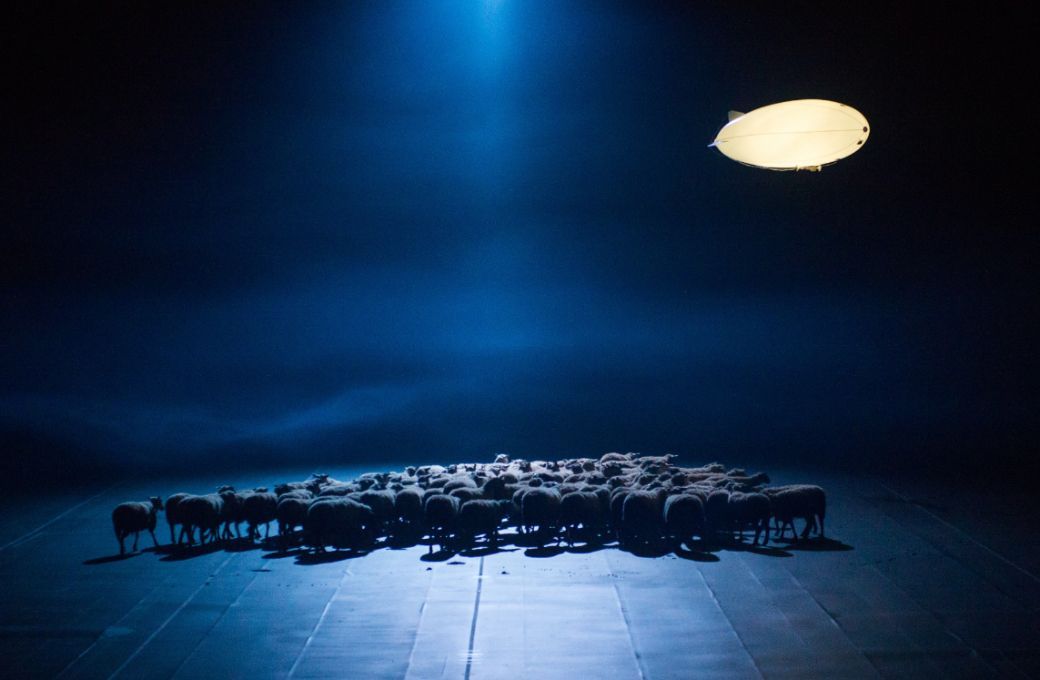Two Irish Wolfhounds lead a nervous crowd through a moonlit forest. A hundred sheep billow onstage, baaing softly. A horse clad in red ribbons and jewels pulls two spear-wielding gods across the stage. Animals onstage are nothing new, and the tradition is alive and well in the 21st century: here, in the Met’s 2011 Lucia di Lammermoor, Heiner Goebbels’s 2014 staging of Andriessen’s De Materie, and FC Bergman’s Il ritorno d’Ulisse in patria, in Geneva this year.
Opera librettos are full of fauna, but there are plenty of ways to convey the presence of animals on the stage without bringing in a menagerie: costumes, masks, puppets, even inflatable water toys, as in the Royal Opera House’s production of Rusalka earlier this year. So why do stage directors keep bringing live creatures onstage?
Animals seem to lend a certain Baroque charm to a performance: either a modern strangeness, or a lavish, old-fashioned over-the-topness. In the case of opera, it’s sometimes both at once: a snake, a couple of dogs, a donkey in a pink velvet hat, these tend to be a sure sign of a well-backed, generously budgeted, serious modern production. Creatures tend to appeal to children, and to audiences in general (their “performances” are often mentioned favourably by reviewers, for instance in the New York Times, and The Guardian). But does this necessarily mean that they have their place onstage? In the era of pushback against circuses and marine parks – even the Moulin Rouge has agreed to stop using snakes in its shows – why does opera escape the opprobrium?
Well, it doesn’t entirely. Berlin State Opera stirred up controversy in 2022 with Dmitri Tcherniakov’s staging of Wagner’s Ring cycle, featuring more than thirty caged guinea pigs and rabbits onstage. After a public appeal by PETA, the opera house modified the production. (Though it does seem worth noting that twenty rabbits were still involved.) The live cow originally featured in Simon Stone’s Traviata was quickly replaced by a tractor, to comply with local animal welfare laws, when the production transferred from Paris to Vienna.
In 2016, the Deutsche Oper am Rhein had to cancel the onstage appearance of Rimsky-Korsakov’s titular Golden Cockerel after the Düsseldorf municipal veterinary’s office nixed Dmitry Bertman’s vision of keeping a live rooster in an undersize cage. The previous year, with Romeo Castellucci at the helm, the Paris Opera cast a 1.5-ton bull as the Golden Calf in Schoenberg’s Moses und Aron. French animal rights protesters stirred up thirty thousand signatures in a petition to the culture minister that nevertheless failed to get the bull off stage, or stop the show from travelling on to Madrid.
In other words, there’s always a bit of a fuss, rarely any real trouble, and nothing much set to change. The show, it seems, must go on. So is the scandal itself the point? Is the buzz of controversy the reason why these productions keep getting staged?
The worries that spark these scandals certainly seem worth taking a closer look at. When I speak to Jessica Lefèvre-Grave, a representative for One Voice, a French animal rights movement, she tells me it’s an error to think we can keep using animals as if they were performers, as if they were simply doing a job. “They’re not working,” she says firmly. “They’re not actors. They don’t want to be there.”
A performance, she reminds me, is something imagined within an entirely human framework, without animals in mind: it’s not a natural setting – “or, in that case, you should set your show in a field!” The noise, the blinding lights, the crowds: all that is only one part of the problem. “You have to remember, training is hardly insignificant. For the animals, it’s another stress entirely.”
Even without access to the complexities of the animal psyche, it’s hard not to feel a pang of sympathy when looking at photos of the Schoenbergian bull on the Paris stage: locked in a small glass box, chained to a metal post, lit by glaring neons. But is it an error to think this is any worse than standard transportation conditions for bovines, or a day at an agricultural show – not to mention the slaughterhouse? Most audiences are hardly horrified by a scene of a character eating a burger, when the implications for animal welfare are far worse. Nevertheless, it seems a kind of false reasoning to think that just because far worse happens to them in other systems of our making, there’s no necessity to protect animals from the specific stresses of the stage. It seems an easy problem to solve. So why aren’t we solving it?
Lefèvre-Grave sees change as something that can only come from the ground up. “We need the art world to take a stand,” she goes on. “We need artists to stand up for nature, for biodiversity.” It’s true that questions of animal exploitation feel even more problematic in the context of the current climate crisis. “The beauty of art should take a stand for the beauty of nature, which is disappearing.”
However, she seems hopeful that things are changing. “This is a pivotal time. It’s never been more important to speak up.” She doesn’t believe that legislation will be the key to a shift in public attitude to animal rights. “If we’ve come so far on the question of animals in the circus, it’s because the audience understood, and stopped attending these performances. This made it a necessity for professionals to evolve in their approach. None of this came from politicians, it didn’t come from laws. It’s up to artists, to those who create these performances, to say: stop, let’s do something different.”
This shift may be happening already. A representative for Ekkifant, the agency which supplied animals for the Berlin Ring, told me they no longer offer animals for public cultural events, out of a consciousness of the audience’s potentially sensitive reactions.
Yet, another more respectful approach may be possible. Heiner Goebbels, who directed De Materie and its hundred sheep first at the Ruhrtriennale, then at the Armory in New York, speaks of his work with the animals with poetry and a great deal of respect.
As a philosophical starting point, Goebbels describes himself as “deeply skeptical about this entire structure of admiring, identifying, mirroring ourselves with protagonists onstage”. He speaks of his interest in Gertrude Stein’s landscape theatre, in decentralisation, in moving away from the idea of the solitary protagonist towards something more collective. Speaking over video call, he tells me he is always looking for alternative ways of creating an artistic experience for the audience. “I was looking for images which confront us with those forces that are beyond human control, somehow.”

He sends me a video of the scene from the production’s third act: on a coolly lit stage, a single blue lightbulb overhead, the sheep move softly to and fro, occasionally bumping into each other, emitting small animal noises that fit perfectly with the piano score, as illuminated golden zeppelins move silently above them. It’s an incredibly peaceful scene of animals living their quiet, animal lives – albeit with a Louis Andriessen score.
Goebbels speaks of his time with the sheep with warmth, describing his first encounter with the flock as “probably one of the most beautiful two hours of rehearsals I have ever had in my life”. In this production, it is clear that great care was taken to make sure the animals were comfortable. The sheep had their own soundproofed paddock, were kept scrupulously apart from the other performers, and munched on “grain and a hay mixture of timothy, orchard grass and red clover”. Ahead of the premiere, Goebbels tells me, the production team invited representatives from animal rights associations, and a number of veterinarians, to attend a rehearsal. Despite collective nerves about the outcome, all attendees gave the show a green light.
Audience reactions were a mix of delight and confusion. “When the sheep came in,” Goebbels tells me, “one lady in the audience said to her neighbour, ‘Don’t worry, they’re not real’, because they were very far away. But very soon, you smelled that they were real!” This question of reality – a holistic vision of the animal – seems key to Goebbels’ conception. “When you stage an animal like you stage a singer or an actor, as a symbol of something, as a sign for something, then you’re already in a trap. For me the sheep were not a symbol, they were sheep.”
There is a sense of poetry in the way Goebbels talks about these sheep that touches on a central, if nebulous, idea that keeps surfacing in my notes: if we are drawn to the presence of real, live animals onstage, it’s because there is simply nothing like them on earth. Unknowable, irreplaceable, unpredictable, they bring a kind of innocence that speaks to our sense of wonder to the stage. Tamino taming the animals with his flute, the Cunning Little Vixen chasing her frog through the forest, the Wagnerian woodbird singing to Siegfried: it seems animals convey a kind of luminous strangeness akin to the magic of opera itself.
The question of consent, and its attendant ethics, nevertheless remains present. When I ask Heiner Goebbels about this – if he thinks the animals have some understanding of what is happening around them, or what they are participating in – he replies wryly, “We will never know.”


